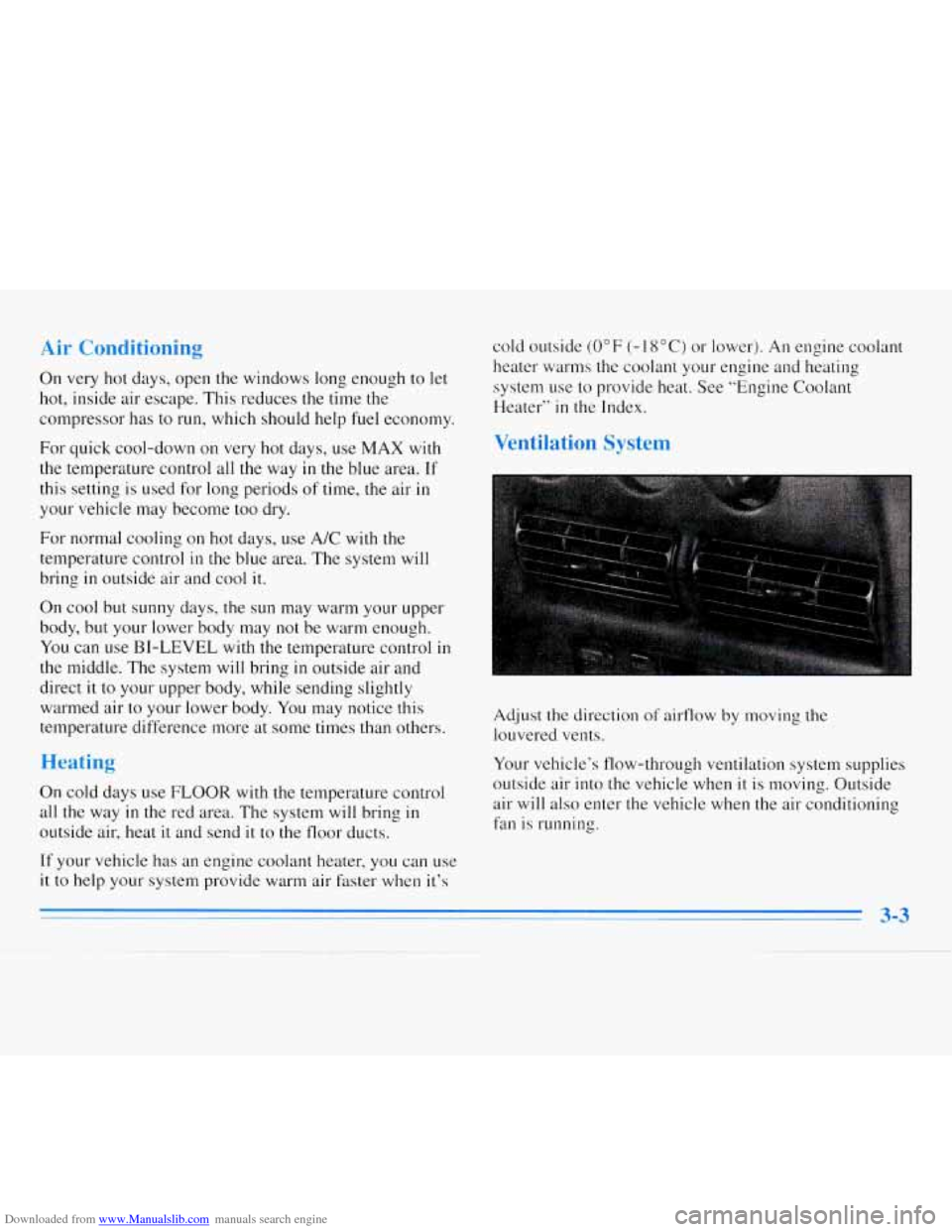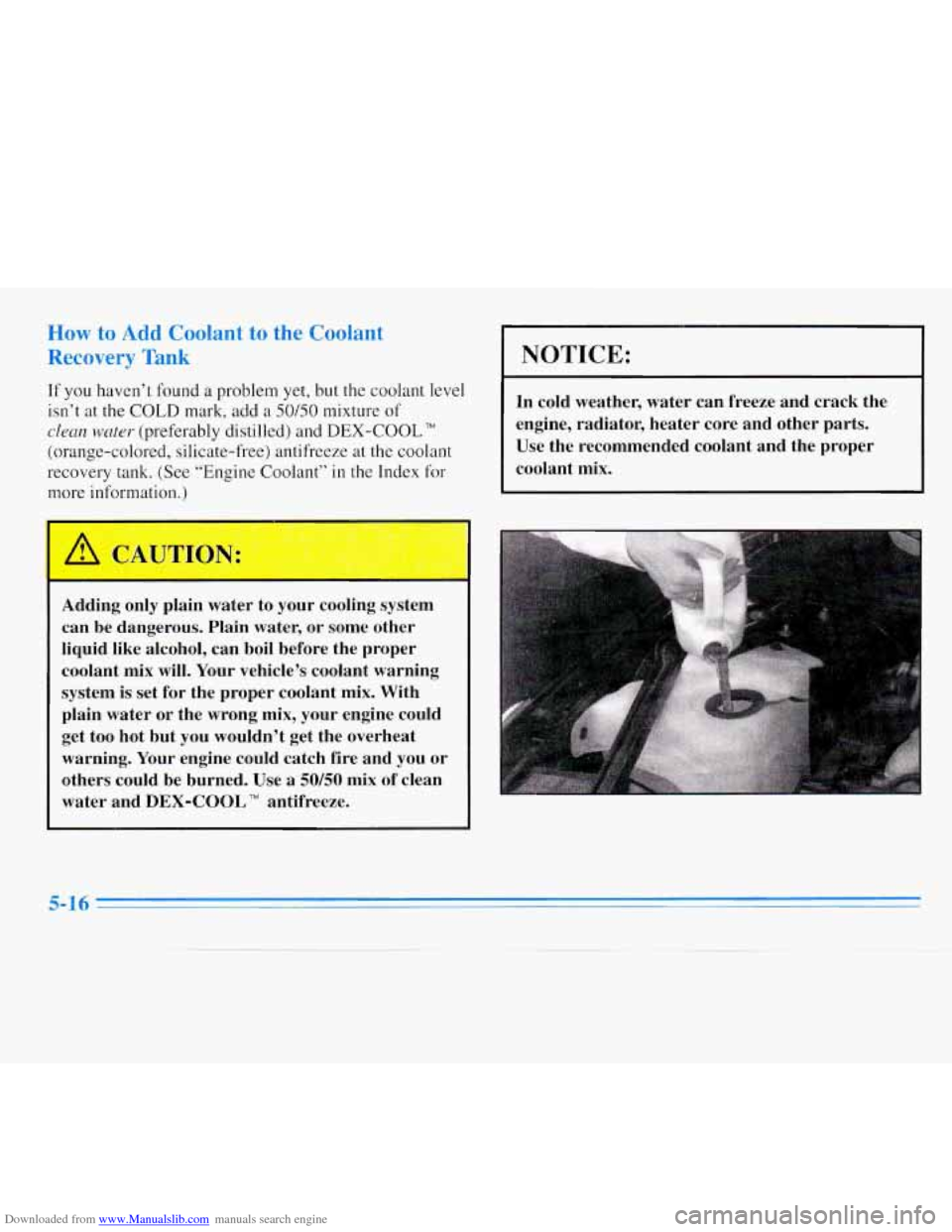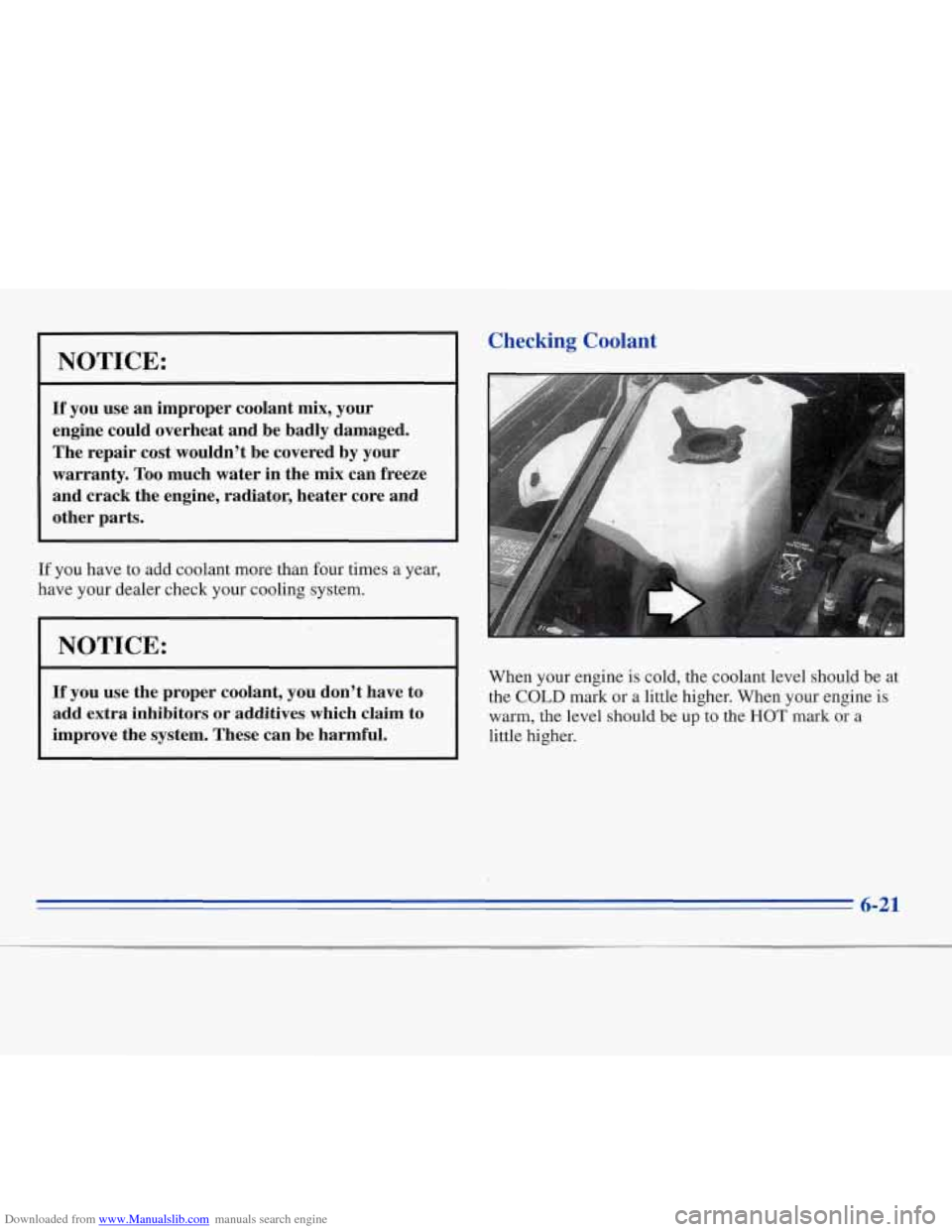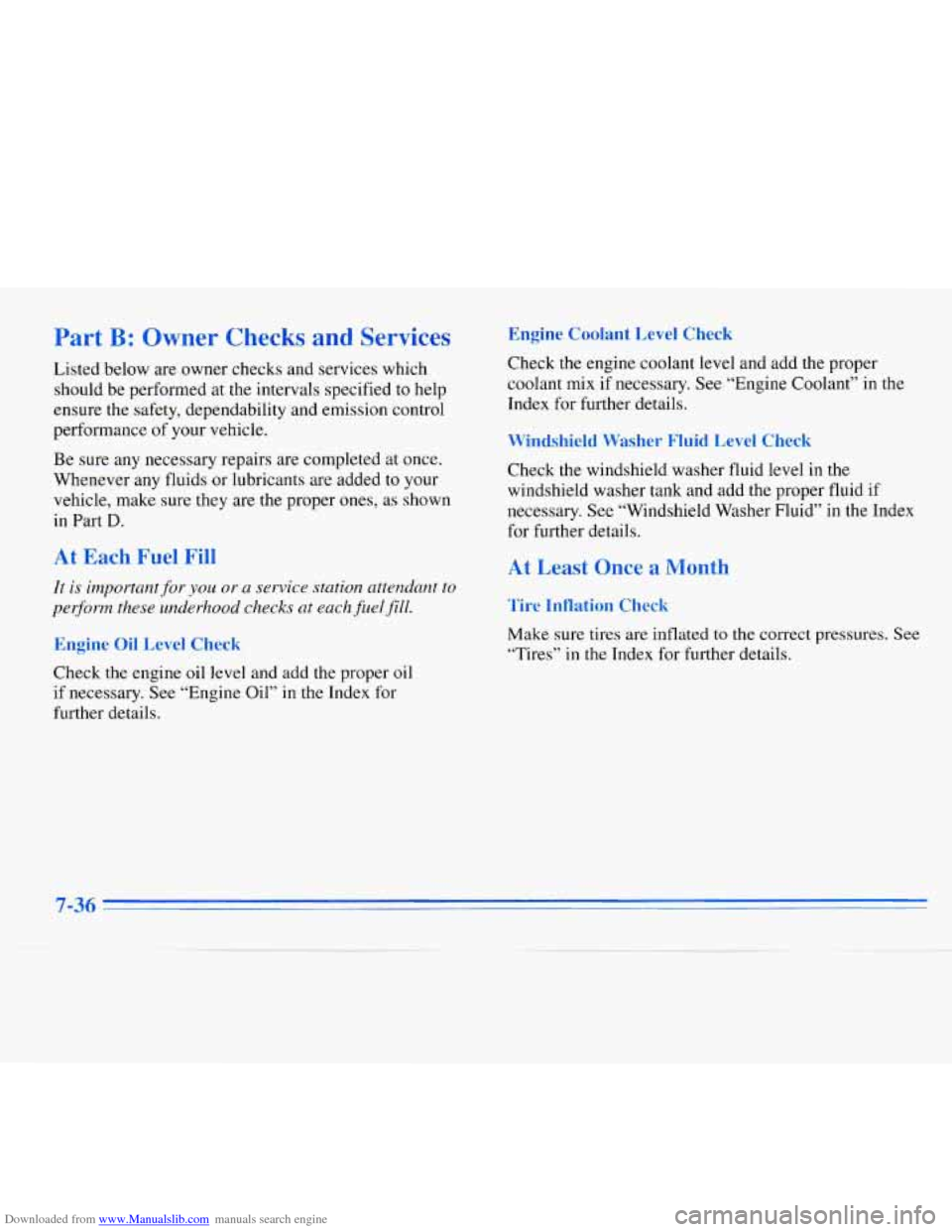1996 CHEVROLET MONTE CARLO coolant level
[x] Cancel search: coolant levelPage 115 of 340

Downloaded from www.Manualslib.com manuals search engine Air Conditioning
On very hot days, open the windows long enough to let
hot, inside air escape. This reduces
the time the
compressor has to
run, which should help fuel economy.
For quick cool-down on very hot days, use
MAX with
the temperature control all
the way in the blue area. If
this setting is used for long periods of time, the air in
your vehicle may become too dry.
For normal cooling on hot days, use A/C with
the
temperature control in the blue area. The system will
bring in outside air and cool
it.
On cool but sunny days, the sun may warm your upper
body, but your lower body may
not be warm enough.
You can use BI-LEVEL with the temperature control in
the middle. The system will bring in outside air and
direct
it to your upper body, while sending slightly
warmed air to your lower body.
You may notice this
temperature difference more at some times than others.
Heating
On cold days use FLOOR with the temperature control
all the way in the red area. The system will bring in
outside air, heat it and send it to the floor ducts. cold
outside
(0°F (-18°C) or lower). An engine coolant
heater warms the coolant your engine and heating
system use to provide heat. See “Engine Coolant
Heater”
in the Index.
Ventilation System
Adjust the direction of airflow by moving the
louvered vents.
Your vehicle’s flow-through ventilation system supplies
outside air into the vehicle when
it is moving. Outside
air
will also enter the vehicle when the air conditioning
fan is running.
If your vehicle has an engine coolant heater, you can use
it to help your system provide warm air faster when it’s
3-3
Page 187 of 340

Downloaded from www.Manualslib.com manuals search engine If the coolant inside the coolant recovery tank is boiling,
don’t do anything else
until it cools down. A CAUTION:
Heater and radiator hoses, and other engine
parts, can be very hot. Don’t touch them.
If you
do, you can be burned.
Don’t run the engine if there is a leak.
If you run
the engine, it could lose all coolant. That could
cause an engine fire, and you could be burned.
Get any leak fixed before you drive the vehicle.
The coolant level should be at or above the COLD mark.
If it isn’t, you may have a leak in the radiator hoses,
heater hoses, radiator, water
pump or somewhere else in
the cooling system.
1 NOTICE:
Engine damage from running your engine
without coolant isn’t covered
by your warranty
If there seems to be no leak, with the engine on, check to
see
if the electric engine fans are running. If the engine
is overheating, both fans should be running.
If they
aren‘t, your vehicle needs service.
Page 188 of 340

Downloaded from www.Manualslib.com manuals search engine Rea
to the - lant
rank
If you haven’t found a problem yet, but the coolant level
isn’t at
the COLD mark, add a 50/50 mixture of
clean water (preferably distilled) and DEX-COOL TM
(orange-colored, silicate-free) antifreeze at the coolant
recovery tank. (See “Engine Coolant” in the
Index for
more information.)
Adding only plain water to your cooling system
can be dangerous. Plain water, or some other
liquid like alcohol, can boil before the proper
coolant mix will. Your vehicle’s coolant warning
system is set for the proper coolant mix. With
plain water or the wrong mix, your engine could
get too hot but
you wouldn’t get the overheat
warning. Your engine could catch fire and you or
others could be burned. Use a
50/50 mix of clean
water and
DEX-COOL TM antifreeze.
1 NOTICE:
In cold weather, water can freeze and crack the
engine, radiator, heater core and other parts. Use the recommended coolant and the proper
coolant mix.
5-16
Page 193 of 340

Downloaded from www.Manualslib.com manuals search engine 8. Start the engine and let it run until you can feel the
upper radiator hose getting hot. Watch out for the
engine fans.
9. By this time the coolant level inside the r' d d' lator
filler neck may be lower. If
the level is lower, add
more
of the proper mix through the filler neck until
the level reaches the base of the filler neck.
10. Then replace the
pressure cap.
At any
time during this
procedure
if coolant
begins
to flow out of
the filler neck, reinstall
the pressure cap. Be
sure the arrows
on the
pressure cap
line up
like this.
11. Check the coolant in the recovery tank. The level in
the coolant recovery tank should be at the HOT
mark when the engine is hot or at the COLD mark
when
the engine is cold.
Page 227 of 340

Downloaded from www.Manualslib.com manuals search engine How to Add Fluid Engine Coolant
Refer to the Maintenance Schedule to determine what
kind
of transaxle fluid to use. See “Recommended
Fluids and Lubricants”
in the Index.
If the fluid
level is low, add only enough of the proper
fluid to bring the level into the cross-hatched area on
the dipstick.
1. Pull out the dipstick.
2. Using a long-neck funnel, add enough fluid at the
dipstick hole to bring
it to the proper level. It doesn’t
take much fluid, generally less than
a pint (OSL).
Don ’t overfill. We recommend you use only fluid
labeled DEXRON@-111, because fluid with that
label is made especially for your automatic transaxle.
Damage caused by fluid other than DEXRON@-I11
is
not covered by your new vehicle warranty.
0 After adding fluid, recheck the fluid level as
described under “How to Check.”
0 When the correct fluid level is obtained, push the
dipstick back
in all the way. The cooling
system in your vehicle is filled with new
DEX-COOL
TM (orange-colored, silicate-free) engine
coolant. This coolant is designed
to remain in your
vehicle for
5 years or 100,000 miles ( 166 000 km),
whichever occurs first.
The following explains your cooling system and how
to
add coolant when it is low. If you have a problem with
engine overheating
or if you need to add coolant to your
radiator, see “Engine Overheating”
in the Index.
A 50/50 mixture of water and the proper coolant for
your Chevrolet will:
0 Give freezing protection down to -34°F (-37°C).
0 Give boiling protection up to 265°F (129°C).
Protect against rust and corrosion.
0 Help keep the proper engine temperature.
0 Let the warning lights and gages work as they
should.
Page 229 of 340

Downloaded from www.Manualslib.com manuals search engine NOTICE:
If you use an improper coolant mix, your
engine could overheat and be badly damaged.
The repair cost wouldn’t be covered by your
warranty.
Too much water in the mix can freeze
and crack the engine, radiator, heater core and
other parts.
If you have to add coolant more than four times a year,
have your dealer check your cooling system.
I NOTICE:
If you use the proper coolant, you don’t have to
add extra inhibitors or additives which claim to
improve the system. These can be harmful.
Checking Coolant
r-
When your engine is cold, the coolant level should be at
the
COLD mark or a little higher. When .your engine is
warm,
the level should be up to the HOT mark or a
little higher.
6-21
Page 308 of 340

Downloaded from www.Manualslib.com manuals search engine Part B: Owner Checks and Services
Listed below are owner checks and services which
should be performed at the intervals specified to help
ensure the safety, dependability and emission control
performance of your vehicle.
Be sure any necessary repairs are completed at once.
Whenever any fluids or lubricants are added to your
vehicle, make sure they are the proper ones, as shown
in Part
D.
At Each Fuel Fill
It is important for you or a service station attendant to
per$orm these underhood checks at each fuel
fill.
Engine Oil Level Check
Check the engine oil level and add the proper oil
if necessary. See “Engine Oil” in the Index for
further details.
Engine Coolant Level Check
Check the engine coolant level and add the proper
coolant mix if necessary. See “Engine Coolant” in the
Index for further details.
Windshield Washer Fluid Level Check
Check the windshield washer fluid level in the
windshield washer tank and add the proper fluid if
necessary. See “Windshield Washer Fluid” in
the Index
for further details.
At Least Once a Month
.Tire Inflation Check
Make sure tires are inflated to the correct pressures. See
“Tires” in the Index for further details.
7-36
Page 331 of 340

Downloaded from www.Manualslib.com manuals search engine Console Storage ................................ 2-35
Control of a Vehicle
.............................. 4-5
Convenience Net
............................... 2-35
Convex Outside Mirror
.......................... 2-34
Coolant
....................................... 6-19
Bleedvalves ................................. 5-19
Heater. Engine ............................... 2- 12
Recovery Tank
............................... 5-16
Cooling System
................................ 5- I4
Courtesy Lamps
................................ 2-3 1
Courtesy Transportation ........................... 8-6
Cruise Control
................................. 2-27
Cupholders
.................................... 2-34
Customer Assistance for Text Telephone Users
......... 8-3
Customer Assistance Information ................... 8- I
Customer Satisfaction Procedure .................... 8- 1
Damage. Finish ............................... 6-50
Damage. Sheet Metal
............................ 6-50
Daytime Running Lamps
......................... 2-30
Dead Battery
................................... 5-2
Defects. Reporting Safety
......................... 8-8
Defensive Driving ............................... 4- 1
Defogger. Rear Window .......................... 3-4
Defrosting
..................................... 3-4
Dimensions. Vehicle
............................ 6-63
Dolby' B Noise Reduction
.................. 3-13. 3- 17
Storage Compartment
......................... 2-35
DoorLocks
..................................... 2-3
Drive Position. Automatic Transaxle
................ 2- 15
Driver Position ................................. 1 - 1 1
Driving Defogging
..................................... 3-4
City
........................................ 4-17 Defensive
.................................... 4-1
Drunken
..................................... 4-2
Freeway
.................................... 4-18
In a Blizzard
................................. 4-24
In Foreign Countries
........................... 6-3
In the Rain .................................. 4-15
Night
...................................... 4-13
OnCurves
................................... 4-8
On Grades While Towing a Trailer ............... 4-33
On Hill and Mountain Roads
.................... 4-21
On Snow and Ice ............................. 4-23
Through Water
............................... 4-17
WetRoads
.................................. 4-15
Winter
...................................... 4-22
With a Trailer
................................ 4-32
Drunken Driving
................................ 4-2
Electrical Equipment. Adding
.......... 2- I I. 3-2 1. 6-52
Electrical System
............................... 6-52
Electronic Climate Control
........................ 3-1
Engine 6-7.
6-8
Coolant
..................................... 6-19
Coolant Heater ............................... 2-12
Coolant Level Check .......................... 7-36
Coolant Temperature Gage
..................... 2-47
Coolant Temperature Light
..................... 2-46
Exhaust
..................................... 2-21
Identification
................................ 6-52
OilLevelCheck
.............................. 7-36
Overheating
................................. 5-12
Running While Parked ......................... 2-22
Specifications ................................ 6-62
Starting Your
................................ 2-11